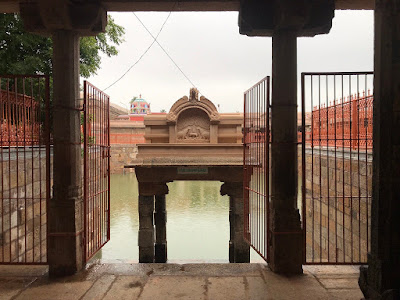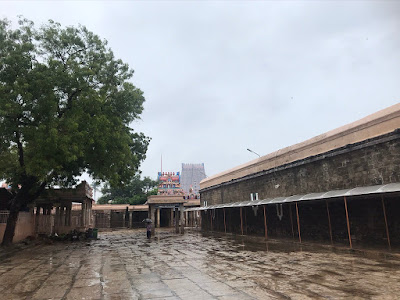There are Temples. Temples of special significance. Temples for performing specific rituals. Temples depicting the Lord's instances. And many many more reasons for a Temple to exist.
And then, there is the temple at Srirangam.
It is widely known that King Vibhishana, brother of King Ravana installed and prayed to the Lord at this temple after Lord Rama gifted this idol to him when the King was returning back to Lanka after the ceremonial consecration of Lord Rama as the King of Ayodhya at the end of the Ramayana War. But there is something interesting how this idol came in to being, in the first place.
Let me explain briefly.
Sriman Narayana created Lord Brahma and the Universe and asked Lord Brahma to create the world which the latter kept doing for many years. Once, he was doubtful of his own ability to keep creating and hence wanted to strengthen his abilities, thereby requesting the Lord to bless him. The Lord appeared in Kurma Roopa (Tortoise form) but Lord Brahma wanted to see His real form to which Sriman Narayana replied that it wasn't so easy to see Him in that form. he ordered Brahma to perform prayers for a thousand years and finally He appeared in the form where He is seen lying on the Adisesha in the celestial ocean (which is none other than the water which flows from his conch - Panchajanya). Brahma thanked Him and prayed to the idol along with the Vimana (the exterior portions included) for many thousands of years.
Later, He passed on the duties to perform prayers to Lord Surya who passed it on to King Manu who passed it on to Ikshvaku of the Surya Dynasty. However, Ikshvaku wasn't sure if he had the ability to pray the way the Devathas prayed at the Satya Loka because he lived in the Bhoo-loka. Therefore, he requested that the Vimana be moved to the Earth and he performed prayers all his life before passing it on to King Dasharatha who prayed for 60,000 years. Then, it was passed on to Lord Rama who offered the idol to King Vibhishana at his behest as a parting gift for all the services the King offered to the Lord during the War at Lanka.
When Vibhishana was returning from Ayodhya with the Vimana, he decided to conduct his evening prayers and thus placed it at the current location on the banks of Cauvery River. However, he wasn't able to remove the Vimana - that is when the Lord informed him that he had given a boon to River Cauvery that He shall decorate her one day by being adjacent to Her. He assured the King that He would be facing the southern direction with His views always on Lanka. It is believed that King Vibhishana visits Srirangam everyday to perform his prayers.
A visit to Srirangam usually ends up with a fast Darshan to the main sanctum sanctorum. However, there are a number of other shrines inside the temple. Lord Dhanvanthri, a form of Maha Vishnu with medicinal herbs on His hands is located on the Northern side of the main shrine. Then there is the unfinished pillar where Lord Narasimha appeared in public when Kambar was invocating the Ramayana to prove that He was none other than Lord Vishnu in the form of Rama & Narasimha.
There is a separate shrine for Lord Rama, Goddess Sita and Lakshmana on the eastern side of the precincts. Closeby, there is a shrine which houses Sriman Narayana in His eternal home at Sri Vaikunta where he is seen seated along with Sri Devi, Bhoo Devi and Neela Devi. There is another shrine of Lord Vasudeva, a rare form of His creation seen at Temples.
Goddess Ranganayaki's shrine has two idols of the Goddess. This is because, during the raid by Mughal king Malik Kafur, the devotees shifted the idol of Lord Ranganatha to a secret location and buried the idol of the Goddess underground. While the idol of Lord Ranganatha was brought back from Tirupati (The Ranga Mandapa at Tirumala was where He was housed & offered prayers during this time), the devotees didn't know where the Goddess' idol was. So they sculpted a new one. However, after a while the original idol was found and was placed in front of the previously installed one.
They say there are temples within a city. But Srirangam is a city inside the Temple. The five layers (prakaras) are none other than the five forms of the Lord - Para Rupa, Vyuha Rupa, Vibhava Rupa, Archa Rupa and Antaryami.
It is not enough to visit this temple once in a lifetime, rather it is the most benevolent boon to reside in Srirangam all our life so we are not reborn again and attain Mukthi to serve the Lord at His feet.




















